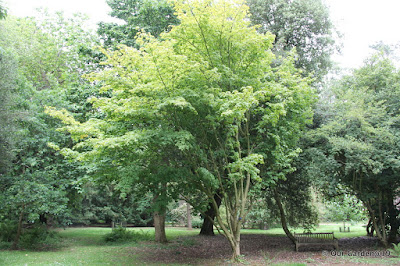The tree following Acer negundo Flamingo has put on a lot of growth since last month...
...with a lot more white in the leaves it lightens up this area of the garden and is a pleasing contrast to the trees behind...
...the leaves are very attractive viewed up close...
...some with more shades of pink than others...
...especially the young growing tip.
Continuing with the tree theme, on Monday we visited Westonbirt, The National Arboretum, based in Gloucestershire, three miles from the Cotswold market town of Tetbury.
The quote below is from their website:
The quote below is from their website:
"The historic, Victorian picturesque landscape and internationally important tree and shrub collection is managed by the Forestry Commission and supported by the Friends of Westonbirt Arboretum.
The 15,000 labelled trees (around 2,500 different types of tree) come from Britain, China, North America, Japan, Chile and other temperate climates. Planting started in the 1850s by Robert Holford; the rich Victorian landowner to whom the Westonbirt estate belonged.
Within the 17 miles of accessible paths and five national collections, children become young adventurers, adults connect with trees through guided walks, workshops, self-led trails or volunteering.
Westonbirt Arboretum consists of three main areas. The Old Arboretum (a dog free area) is a carefully designed landscape dating from the 1850s offering beautiful vistas, stately avenues and trees from around the world.
Silk Wood is an ancient, semi-natural woodland which has exotic plantings throughout its landscape, whilst the Grade I registered Downs hosts species-rich grassland and is a great picnicking location."
You enter through the new Welcome Building walking through the Grade 1 registered Downs...
...we walked around the Old Arboretum, Westonbirt is world renowned for its Acer collection.
 |
| Acer palmatum 'Westonbirt Red' |
 |
| A. argutum 'Sharpe-toothed Maple' The leaves certainly live up to its name. |
Rhododendron 'Loderi Seedling'...
 |
...with attractive red bark. |
The common Oak Quercus Robur, with some unusual growths on the trunk, does anyone know what they are, there was no explanation on the label...
...Taxus baccata, Common Yew, they always look so ancient and usually are...
...the Rhododendron 'Martin Hope Sutton' with its petals providing a colourful woodland carpet...
From a distance I would never of guessed this tree was...
...an Hydrangea, H. heteromalla, until you see the flowers up close...
...nor that this tree is a Rhododendron...
...R. Viscosum "Swamp Honeysuckle," the scent was wonderful, thankfully not at all swamp like.
A team was preparing this area for a music concert by McBusted on the 12th July, they now hold several similar events during the year.
I think the new Welcome Building was built with these events in mind, talking to visitors on the day it is not popular due to its distance from the picnic and cafe area making access difficult for the less able visitors.
You can read more about Westonbirt Here
Please visit Loose and Leafy Here to see what other tree followers are posting for July.
Click on any photo to create a slide show.

















The Acers include so much wonderful variation, but I think your A. n. Flamingo must be among the best for brightening a dark patch!
ReplyDeleteIt is I think a very special tree, pollarding it each winter appears to improve it and prevent it reverting.
DeleteThank you for your comment, Brian, on my Acer negundo, which is nothing near as fine as your A. n. Flamingo. Our neighbour opposite has a small one of these, which we absolutely love ... as do the blackbirds, who hover around the base.
ReplyDeleteP.S. Forgot to say how much we like Westonbirt, too. We used to go quite a bit en route from Swansea (in those days) to relatives in England.
ReplyDeleteWe use to visit quite often too when we lived down there, it was free to go in at certain times of the year then. It now cost £9 each all year!
DeleteReally interesting post -- and yours is a very nice tree! The leaves are simply wonderful.
ReplyDeleteIt is a lovely tree, Anna. We wouldn't what to be without it.
ReplyDeleteYour tree is beautiful, I love trees with pink leaves. I would love to go to Westonbirt in the Autumn to see the Acers firing up.
ReplyDeleteThe growths on your Oak tree are called ' burls'. They are thought to be the result of stress or damage but they don' t seem to cause long term problems for the tree. I think they give it character.
Thank you for the info Chloris. They do give the tree character, you could imagine it coming to life in a Harry Potter type film.
DeleteAmazing leaves, beautiful! I have to wonder - do they have less chlorophyll than fully green leaves and if so, how does the tree get by? Does it grow more slowly?
ReplyDeleteI am no scientist Hollis, but I would image they must have less chlorophyll, most variegated plants are known to have less vigour than their normal form. This isn't the case though with this Acer. I pollard it every spring, If you look back through the tree following links you will see its growth rate.
DeleteI love Westonbirt and go every year for the Autumn colour. I wonder if those growths on the Quercus are as a result of something like the Gall Wasp. I know it can effect the branches of Oak but I've never seen a trunk badly effected like that
ReplyDeleteHello Gina, Chloris in her comment above said they are called 'burls' and are no problem for the tree. I did think of the gall wasp but I think that is on the leaves.
DeleteI am NO expert in this field!
Westonbirt has long been on my must visit list. Perhaps I'll make it before my maternity leave runs out...
ReplyDeleteAutumn is the ideal time to go when all the Acers and Maples are changing leaf colour.
Delete